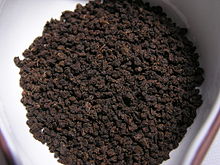- Crush, Tear, Curl
-
Crush, Tear, and Curl (also Cut, Twist, Curl) is a method of processing black tea, similar to that of orthodox tea manufacture. Instead of the leaves being rolled as a final stage, they are passed through a series of cylindrical rollers with hundreds of small sharp "teeth" that Crush, Tear, and Curl.
CTC was invented by W. McKertcher in 1930-1931, and it spread in the 1950s through 1970s most quickly in India and Africa. Today, most of the black tea produced are of CTC manufacture, or by the closely related rotovane orthodox manufacture. CTC and rotovane orthodox have a finished product is well suited for tea bags, as it quickly gives a coloury brew.
For many large tea producers, 80% to 90% of the factory's production is of small, broken, primary grades suitable for tea bag blends; the balance 10% to 20% are secondary grades which trade at a discount to the primary grades.
In the Indian domestic market, this type of manufacture is by far the most popular - over 80% of tea production is of the CTC type, amounting to approximately 650 million kg. In the export market, particularly in the C.I.S., the Middle East, United Kingdom and Ireland, CTC teas continue to be the most highly in demand.
CTC teas generally produce a rich red-brown color when they are boiled by the Indian method. (One boils the leaves with milk, water and sugar and spices (producing Masala Chai)).
The drawback of the CTC method is that it tends by its nature, and unfortunately by adulteration, to homogenize all black tea flavors. In the process of crushing, tearing and pelletizing the tea leaves, large pressures and stresses occur which break down the cells, releasing large amounts of the phytins that nominally oxidize to produce black tea's mahogany color. Therefore, CTC teas are intrinsically quite darkly pigmented.
Since regardless of origin, CTC teas in their dry form are generically "tea-like" in aroma, very similar in pelletized form, it is very easy to adulterate a more expensive (and presumably higher quality) CTC with inexpensive and generally mild lowland teas of the same process. Whole and broken leaf teas by contrast are quite varied in appearance, making adulteration at the very least difficult.
There is some question whether the CTC processed teas retain much (or any) of the widely referenced polyphenyls and other bio-reactive compounds that are thought to have positive herbal effects.
The convenience, low price, strong liquor, generic flavor, mild bitterness (tannins) have contributed to the near-monopoly that CTC type teas now enjoy in the homeland of Tea itself.
See also
External links
Categories:
Wikimedia Foundation. 2010.

